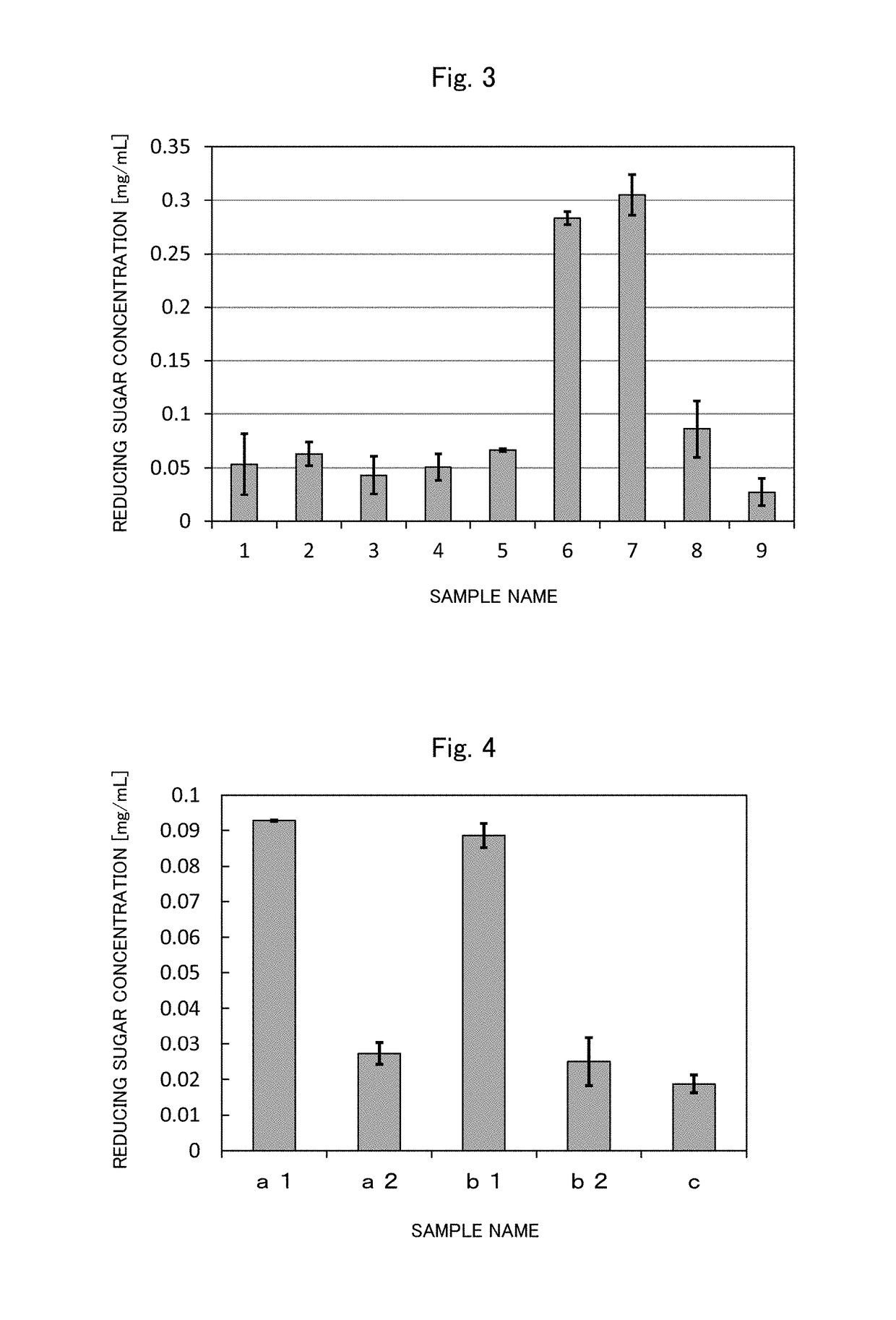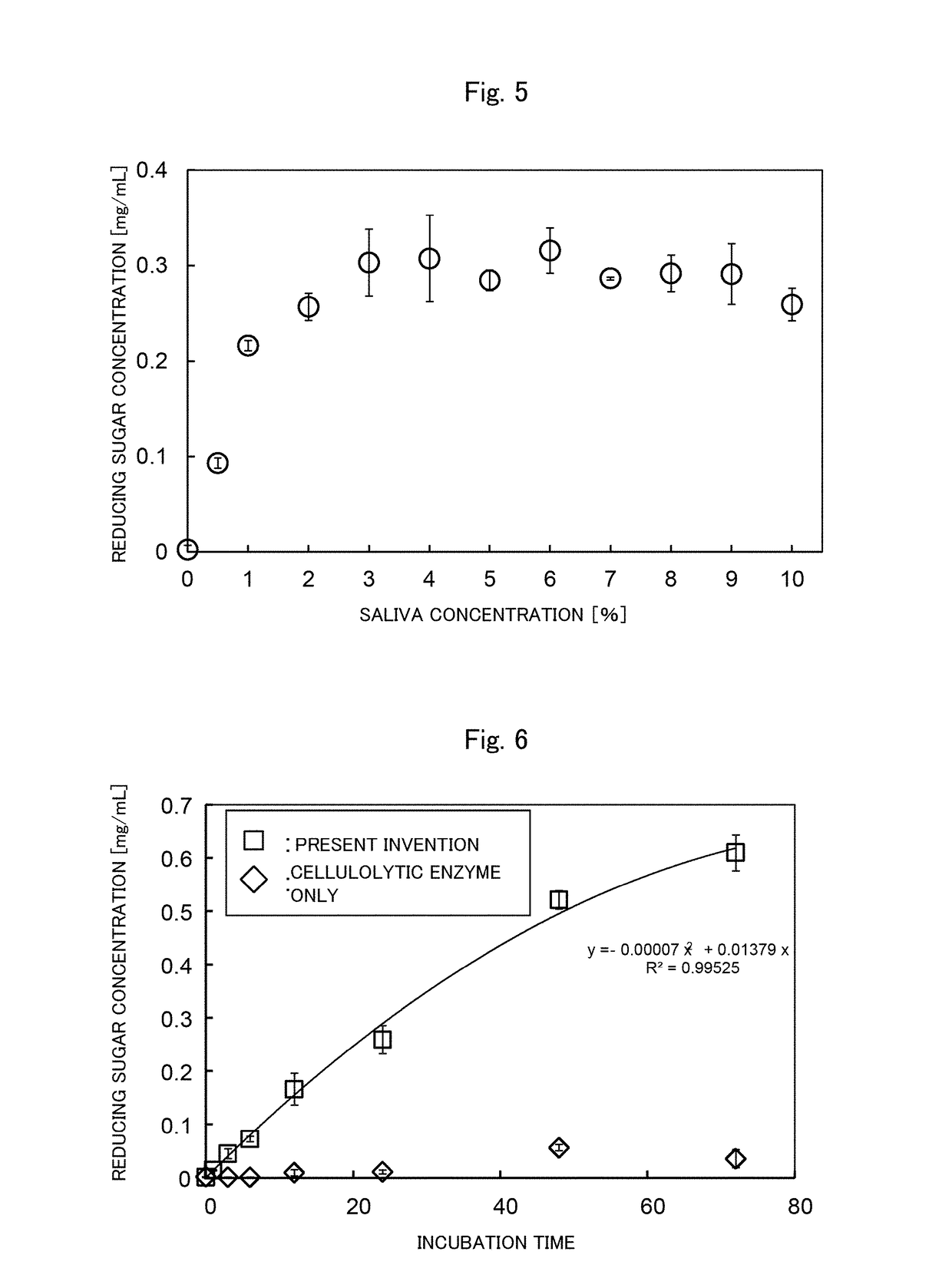Glucose production method and glucose produced by said method
a production method and technology of glucose, applied in the field of glucose production method, can solve the problems of difficult to significantly improve the glucose yield, rigid crystalline components of cellulose raw materials, etc., and achieve the effects of low price, reduced cost of safety management in production plants, and significant improvement of glucose yield
- Summary
- Abstract
- Description
- Claims
- Application Information
AI Technical Summary
Benefits of technology
Problems solved by technology
Method used
Image
Examples
example 1
[0046]In example 1, glucose was produced using saliva from cattle as the saliva from living matter.
[0047]In the present example, Avicel (manufactured by Merck & Co., Inc.), which is a microcrystalline cellulose, was used as the cellulose raw material. Avicel at a concentration of 1% was added to a 50 mM buffer solution, and a 10 μg / mL substrate suspension was obtained. A cellulase (Trichoderma Viride (manufactured by Sigma-Aldrich Corporation)) was used as the cellulolytic enzyme. 500 μg of the cellulase per 1 mL of the 50 mM buffer solution was diluted five-fold with the reaction mixture, and finally a 100 μg / mL enzyme was used in the reaction mixture. Undiluted saliva collected from the mouths of cattle that has been diluted 50-fold with the reaction mixture was used as the saliva from cattle. As the buffer solution, an aqueous sodium acetate solution having a pH of 4.0 was used in each instance.
[0048]In the glucose production method of the present example, first, 15 μL of the 100...
example 2
[0054]In example 2, glucose was produced using an activating auxiliary solution obtained by an organic compound being extracted from cattle saliva, as the activating auxiliary agent derived from biological saliva.
[0055]Here, the method for extracting an organic compound from cattle saliva will be described.
[0056]First, 10 ml of cattle saliva is boiled for 10 minutes. The protein component within the saliva that has been denatured by heat is adsorbed into a solid-phase extraction column (Oasis HLB 12 cc (500 mg) LP Extraction Cartridge, manufactured by Waters Corporation). A 100% aqueous methanol solution is added to the solid-phase extraction column, and a solution containing organic compounds is extracted. In addition, evaporation, drying, and solidification are performed by a nitrogen stream, and a solid matter is obtained. The obtained solid matter is dissolved in a buffer solution to 1 mg / mL. An auxiliary agent solution is thereby prepared. Through use of an aqueous methanol sol...
example 3
[0061]In example 3, glucose was produced using saliva from donkeys as the saliva of living matter. As comparison, glucose was also produced using saliva from cattle under the same conditions.
[0062]The cellulose raw material and the cellulolytic enzyme described in example 1 was used. In the present example, 500 μg of cellulase per 1 mL of the 50 mM buffer solution was suspended in the reaction mixture, and diluted ten-fold with the reaction mixture. Finally, a 50 μg / mL enzyme was used herein.
[0063]Details of the samples are as follows: sample a1 was obtained by adding 15 μL of the 50 μg / mL enzyme solution and 15 μL of the cattle saliva to 120 μL of the 10 μg / mL substrate suspension; sample a2 was obtained by adding only 15 μL of the cattle saliva to 120 μL of the 10 μg / mL substrate suspension, and adjusting the resultant to a total amount of 150 μL with the buffer solution; sample b1 was obtained by adding 15 μL of the 50 μg / mL enzyme solution and 15 μL of the donkey saliva to 120 μ...
PUM
| Property | Measurement | Unit |
|---|---|---|
| concentration | aaaaa | aaaaa |
| pH | aaaaa | aaaaa |
| concentration | aaaaa | aaaaa |
Abstract
Description
Claims
Application Information
 Login to View More
Login to View More - R&D
- Intellectual Property
- Life Sciences
- Materials
- Tech Scout
- Unparalleled Data Quality
- Higher Quality Content
- 60% Fewer Hallucinations
Browse by: Latest US Patents, China's latest patents, Technical Efficacy Thesaurus, Application Domain, Technology Topic, Popular Technical Reports.
© 2025 PatSnap. All rights reserved.Legal|Privacy policy|Modern Slavery Act Transparency Statement|Sitemap|About US| Contact US: help@patsnap.com



